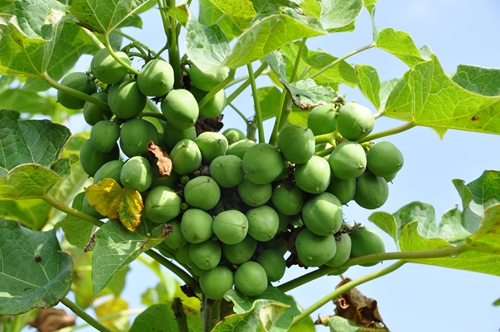Jatropha curcas (hereafter referred to as Jatropha), a perennial deciduous shrub belonging to the family Euphorbiaceae whose seed content is approximately 30–40% oil, is an ideal feedstock for producing biodiesel and bio-jet fuels. However, currently the seed yield of Jatropha is poor and insufficient for the biodiesel industry. Researchers reported that applying plant growth regulators to Jatropha can improve seed yield. Prof. XU Zengfu and his team of Xishuangbanna Tropical Botanical Garden (XTBG) have been engaged in studying how to improve seed yield of Jatropha for a few years. Their previous study has found that applying benzyladenine (BA, a synthetic cytokinin) to the inflorescence meristems of Jatropha significantly increased the flower number and the female to male flower ratio and also induced bisexual flowers in Jatropha, which contributed to an increase in seed yield.
The researchers further conducted a time course study of gene expression profiles in inflorescence meristems of Jatropha following cytokinin treatment using transcriptome sequencing by a 454 GS FLX Titanium instrument. One 454 sequencing run was performed that generated a total of 294.6 Mb of transcript sequences. Differentially expressed genes involved in the biosynthesis, metabolism, and signaling of cytokinin and other plant hormones, flower development and cell division, which may be related to the phenotypic changes of Jatropha in response to cytokinin treatment, were further analyzed.
The cytokinin signaling pathway was found to crosstalk with other signals, mainly through pathways converging on or through transcriptional factors or other signaling components. Along with the altered expression of these ABCE model genes, bisexual and asexual flowers were induced. But no abnormal floral organ development was found in Jatropha, which was induced by BA treatment in Arabidopsis, indicating different mechanisms to be involved in the floral organ development of unisexual flowers of Jatropha and bisexual flowers of Arabidopsis. Several cell division-related genes, including JcCycA3;2, JcCycD3;1, JcCycD3;2 and JcTSO1, were up-regulated, which may contribute to the increased flower number after cytokinin treatment.
It is the first report on the transcriptional regulation and identification of genes that are differentially expressed in the inflorescence meristems of Jatropha exposed to cytokinin. The potential cytokinin-responsive transcripts identified in this study will provide a good starting point for investigations into the molecular mechanisms of Jatropha responses to cytokinin.

